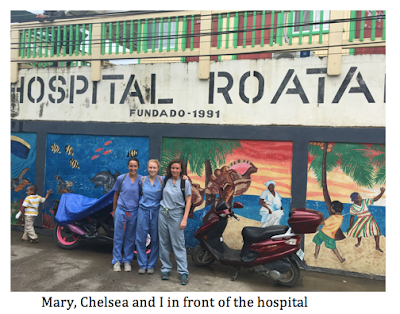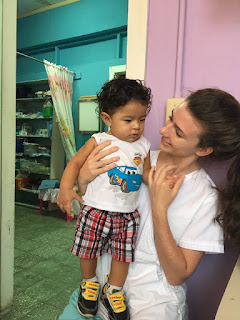Casey (February-March 2017)
I decided to volunteer in Roatan, Honduras with Global
Healing to gain more knowledge about medicine, experience all the fun
activities Roatan has to offer, practice my Spanish, and meet new people. I more
than accomplished all of these goals after my month spent on the island. My time
in Roatan completely exceeded all expectations (including my expectation to
find great diving in Roatan which was just as good as the books said!).
The Pediatric Clinic run by Global Healing is located in the
Public Hospital in Roatan’s “largest” city Coxen Hole. By “large”, I mean the
city with the most local island residents. Other “large” cities include West
End and West Bay, simply due to the fact they are flooded with tourists and
expats. Roatan has a large economic gap between the tourists and the local
Honduran people. Most people come off the cruise boats and head straight to West
End and West Bay for beaches and diving. However, they miss the other, poverty
stricken side of the island. Coxen Hole embodies true Roatan and the local
people without tourists, cruise boats, nor fancy resorts and restaurants.
I was so fortunate to have worked with the most awesome
pediatric residents from NYU, Chelsea and Mary. I am quite certain my
experience would not have been nearly so great without them. They were both
eager to share with me patient diagnosis and teach me about medicine. And, outside
of the clinic, we never stopped exploring the island! I must say, the three of us were perfect matches! We
also worked with Dra. Cerritos. She is the local Honduran doctor running the
clinic year-round meanwhile doctors from the U.S. come monthly to help her. The
moms LOVED Dra. Cerritos; She really has a way with her patients and connects
with the moms so well.
Every morning, we arrived to the hospital after a 30-40
minute collectivo ride from West End. Our mornings consisted of checking on the
mothers with their newborns in the maternity ward, and then seeing 15 or so
patients. As an intern, I greeted the kids and their moms, triaged the patients
and kept records in their file.
ALL the kids were so darn cute, especially the babies! Before arriving
in Roatan, I thought I would be using only Spanish to talk with the patients.
However, the island has a large population of native islanders with English being
their first language. Roatan used to be a British colony, so today many native
people speak English. However, their English is very different, called “Island
English,” and it sounds like they are speaking another language. These native
island English speakers can also speak “proper English” (as they call it) and
they learn Spanish in school. I found this very interesting.
Most the patients seen at the clinic came for niño sano (well-child)
visits, or they had gripe (common cold). A common misunderstanding with most
parents was that they thought their sick kids with gripe needed antibiotics,
but as most educated people know, colds are viral infections that will cure
themselves. It was not that the moms were not smart, but the local people
lacked medical information and awareness. For example, one of the most
seriously ill patients seen in the clinic had obvious swollen neck lymph nodes.
The mom said his neck had been growing for the past month and the boy had been
running a fever for some time. It was shocking to see how large they were, and
to think why the mom had not brought her child in earlier. The boy was admitted
to the hospital after seeing him in the clinic. He needed to be sent to either
Tegucigalpa or San Pedro Sula, Honduras’ largest cities for biopsy since he
most likely had lymphoma. Because
the island has limited medical care, many people are sent to the mainland for
special procedures. Dr. Cerritos told us that sending patients to the mainland
is complicated, especially since many of them have never even left the island.
In some cases, the hospital sends a social worker to escort the patient and
their family to make sure they do not get lost since it is a long haul: a 1.5
hour ferry ride to La Ceiba and then a 4-6 hour bus ride to Tegucigalpa or San
Pedro Sula. Luckily the hospital has an agreement with the ferry so that
patients do not have to pay. I cannot image having to travel so far for medical
care, leaving behind their families on the island.
During my time, I collected data for the clinic on patient
information, diagnosis, and treatment. The three top diagnoses were well child
checkups, common cold, and parasitic worm infections. Parasites are very common
in children in developing countries. I remember a little girl came into the
clinic with terrible abdominal pain. Dra. Cerritos suspected she needed an appendectomy.
The girl went into surgery, but instead of appendicitis, she had worms in her
gut. I felt so bad for the poor girl. To prevent such infections, children are
routinely prescribed anti-parasitic drugs beginning at one year old. The third
most prescribed medication behind acetaminophen and multi-vitamins was
albendazole for treatment of parasites.
We are so lucky in the United States to have clean water and safe food
so that we do not have to worry about such infections.
The hospital was an interesting place. It was not modern and
lacked newer technology but was sufficient to provide for the patients. Our
room in the clinic had sinks, but no running water. Patient charts were all
kept in manila folders. The folder room was stuffed with thousands of folders.
Every day, it was not uncommon for patient folders to be empty when I reviewed the
patient’s history because the folder was lost or buried somewhere in the folder
room. Despite a third world feel to the hospital, patients were seen and
treated by competent doctors.
The residents, Chelsea, and Mary, and I had fun working at
the clinic. For me, I was able to learn and observe more than I could in the
U.S. I also really enjoyed interacting with the kids and their moms. For
Chelsea and Mary, they thought how lucky they were to spend a month of their
residency training helping the clinic while enjoying Roatan! Hint to new
interns and residents: there is the best paleta (popsicle) shop very close to
the hospital! I swear we went there at least three times a week, if more!
We definitely took advantage of Roatan activities after
clinic everyday. Highlights
included diving, snorkeling, beach runs, and our favorite: the Swing Boat.
Someone left his sailboat floating in the middle of Half Moon Bay in West End
with a rope swing for everyone to enjoy. Our apartment was 20 steps from the
beach in Half Moon Bay, so I think we must have went to the Swing Boat at least
a dozen times. We also tried almost every restaurant in West End, and we quickly
learned how great baleadas are. Baleadas are thick freshly made tortillas
filled with beans, cheese, meat or pretty much anything you want! We decided to venture off the island
too. One weekend we went river rafting in La Ceiba on the mainland of Honduras.
Another weekend, we went to the small nearby island of Utila for diving and
nightlife.
Thank you Global Healing and Roatan for giving me such a
wonderful opportunity. I highly recommend pre-meds and other pre-health
students to consider this program because I want others to have a rewarding and
fun experience like I did! And lastly, hopefully one day I will return on the
other side of medicine, as a medical professional!
 |







Comments
Post a Comment